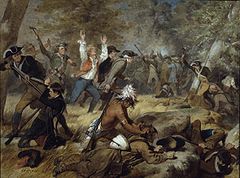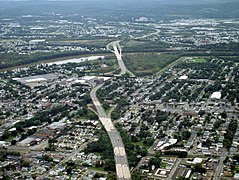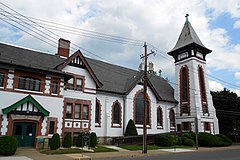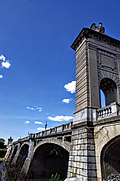|
Kingston, Pennsylvania
Kingston is a borough in Luzerne County, Pennsylvania, United States. It is located on the western bank of the Susquehanna River opposite Wilkes-Barre. Kingston was first settled in the early 1770s, and incorporated as a borough in 1857. As of the 2020 census, the population was 13,349, making it the most populous borough in Luzerne County.[5] HistoryEarly historyIn the early 1660s, King Charles II owed Admiral Sir William Penn a large sum of money. To settle this debt, he granted Penn's son, William, a territory in North America, which later became known as Pennsylvania. However, Connecticut also claimed a portion of this land. Count Zinzendorf was one of the first people to take an interest in the Wyoming Valley. In 1742, he came to the region to convert the Native Americans to Christianity. At the time, the valley was inhabited by several Native American tribes (including the Susquehannock and the Delaware). His reports led a group of Connecticut settlers to form the Connecticut Susquehanna Company. This company bought the land from the natives. In 1768, they met in Hartford, Connecticut, and decided to survey and divide the territory into five townships (each one was five square miles). The plan was to sell and divide each township among forty settlers. The first forty pioneers took possession of Kingston Township. By the late 1760s, both Connecticut and Pennsylvania settlers fought over this territory. The conflict was eventually settled in the 1780s. The disputed land was granted to Pennsylvania. The location of modern-day Kingston became part of Northumberland County. However, Connecticut settlers remained determined to create a new state in northeastern Pennsylvania. Timothy Pickering was sent to the region to politically examine the situation. This led to the Pennsylvania Assembly passing a resolution which created Luzerne County. This ended the idea of creating a new state. Luzerne County was created from part of Northumberland County. Under Pickering's leadership and direction, county elections were held, the courts were established, and a government was formed.[6] Revolutionary War On June 30, 1778, Loyalist forces, under the command of Major John Butler, arrived in the Wyoming Valley to attack the American settlements. On July 1, Fort Wintermoot at the north end of the valley surrendered without a shot being fired. The next morning the smaller Fort Jenkins surrendered. Both forts were later burned to the ground. Meanwhile, the Patriot militia assembled at Forty Fort. On July 3, a column of roughly 375 men including a company of soldiers in the Continental Army marched from the fort under the command of Lieutenant Colonel Zebulon Butler and Colonel Nathan Denison. Major Butler's Rangers, with the assistance of about 500 indigenous allies, ambushed the oncoming Americans. In the end, nearly 300 Patriot soldiers from the Wyoming Valley were killed during the Battle of Wyoming, commonly known as the Wyoming Massacre.[7] The next day Colonel Denison surrendered Forty Fort along with several other posts. Widespread looting and burning of buildings occurred throughout the Wyoming Valley subsequent to the capitulation, but non-combatants were not harmed.[7] Most of the inhabitants, however, fled across the Pocono Mountains to Stroudsburg and Easton or down the Susquehanna River to Sunbury. IncorporationThe community has a rich history in American education. It is said that the first public school in Pennsylvania was erected in Kingston (in the 1770s).[8] The borough is also home to the Upper School of Wyoming Seminary, a prestigious college preparatory school founded in 1844. During the first year, it enrolled 31 students (17 boys and 14 girls). Today, Wyoming Seminary's historic campus hosts roughly 450 students. Kingston witnessed a population boom after the construction and operation of the Lackawanna and Bloomsburg Railroad. It was incorporated as a borough on November 23, 1857. The borough is named after Kingston, Rhode Island.[6] The first election for the community was held on December 15, 1857. Ruben Jones was elected burgess and justice of the peace. Some of the first council members elected included Bestor Payne, Marshall G. Whitney, Reuben Marcy, Thomas Pringle, and Richard Hutching.[8] In 1923, the Kingston Armory was built. On September 11, 1950, 33 guardsmen from the 109th Field Artillery Regiment were killed in a train accident near Coshocton, Ohio. In the following days, the dead were moved to the Kingston Armory, where the remains were relinquished to the grief-stricken families.[9] Coal mining was a chief industry in and around Kingston prior to the Knox Mine Disaster. The 1959 tragedy essentially shut down the mining industry in and around the borough.[10] In June 1972, Kingston was devastated by the flooding of Hurricane Agnes. The hurricane wreaked havoc on Kingston and neighboring Wilkes-Barre, causing a state of emergency. The natural disaster earned national attention and a visit from President Richard Nixon, who recruited Wyoming Seminary graduate Frank Carlucci (Nixon's head of the Department of Health, Education, and Welfare) as a point man to oversee flood recovery efforts. After the flood, Kingston adopted a home rule charter. It became effective in January 1976. Former Presbyterian Church in Kingston Geography  Kingston lies within the Wyoming Valley of Northeastern Pennsylvania. It is situated on the western bank of the Susquehanna River in the northern half of Luzerne County. According to the U.S. Census Bureau, the borough has a total area of 2.2 square miles (5.7 km2), of which 2.1 square miles (5.5 km2) is land and 0.08 square miles (0.2 km2), or 3.61%, is water.[11] It is separated from Wilkes-Barre by the Susquehanna River and the boundary of Kirby Park. Its numbered routes are U.S. Route 11 and Pennsylvania Route 309, which follows the Cross Valley Expressway from the Back Mountain area to Interstate 81 and Route 115 east of Wilkes-Barre City. Market Street and Pierce Street connect Kingston with center city via bridges. Besides neighboring Wilkes-Barre, Kingston also borders the communities of Edwardsville, Pringle, Luzerne, and Forty Fort. The Borough of Kingston is served by the Wilkes-Barre Wyoming Valley Airport (near Forty Fort) and the Wilkes-Barre/Scranton International Airport (in Pittston Township). ClimateKingston has a humid continental climate (Köppen climate classification Dfa/Dfb) with four distinct seasons. Winters are cold with a January average of 25.8 °F (−3.4 °C).[12] The surrounding mountains have an influence on the climate (including both precipitation and temperatures), leading to wide variations within a short distance.[13] On average, temperatures below 0 °F (−17.8 °C) are infrequent, occurring three days per year, and there are 36 days where the maximum temperature remains below 32 °F (0.0 °C).[13] The average annual snowfall is 46.2 inches (117 cm) during the winter (in which severe snowstorms are rare).[13] However, when snowstorms do occur, they can disrupt normal routines for several days.[13] Summers are warm, with a July average of 71.4 °F (21.9 °C).[12] In an average summer, temperatures exceeding 90 °F (32.2 °C) occur on an average of nine days and can occasionally exceed 100 °F (37.8 °C).[14] Spring and fall are unpredictable, with temperatures ranging from cold to warm (although they are usually mild). On average, Kingston receives 38.2 inches (970 mm) of precipitation each year, which is relatively evenly distributed throughout the year (though the summer months receive more precipitation).[14] Extreme temperatures range from −21 °F (−29.4 °C) on January 21, 1994, to 103 °F (39.4 °C) on July 9, 1936.[14] Kingston averages 2,303 hours of sunshine per year, ranging from a low of 96 hours in December (or 33% of possible sunshine) to 286 hours in July (or 62% of possible sunshine).[15] Kingston straddles the hardiness zone boundary between 6a and 6b, meaning that the average annual absolute minimum temperature is approximately -5 °F.[16]
Demographics
As of the 2000 census,[19] of there were 13,855 people, 6,065 households, and 3,372 families residing in the borough. The population density was 6,461.6 inhabitants per square mile (2,494.8/km2). There were 6,555 housing units at an average density of 3,057.1 per square mile (1,180.4/km2). The racial makeup of the borough was 96.84% White, 0.77% African American, 0.07% Native American, 1.53% Asian, 0.01% Pacific Islander, 0.29% from other races, and 0.50% from two or more races. Hispanic or Latino of any race were 0.80% of the population. There were 6,065 households, out of which 23.1% had children under the age of 18 living with them, 40.7% were married couples living together, 11.3% had a female householder with no husband present, and 44.4% were non-families. 40.1% of all households were made up of individuals, and 20.5% had someone living alone who was 65 years of age or older. The average household size was 2.16 and the average family size was 2.94. In the borough, the population was spread out, with 19.7% under the age of 18, 7.5% from 18 to 24, 25.6% from 25 to 44, 22.8% from 45 to 64, and 24.4% who were 65 years of age or older. The median age was 43 years. For every 100 females, there were 83.9 males. For every 100 females age 18 and over, there were 78.9 males. The median income for a household in the borough was $33,611, and the median income for a family was $45,578. Males had a median income of $34,069 versus $24,482 for females. The per capita income for the borough was $20,568. About 8.2% of families and 11.3% of the population were below the poverty line, including 11.7% of those under age 18 and 10.3% of those age 65 or over. Religion59.27% of the people in Kingston, Pennsylvania, are religious—meaning they affiliate with a religion. 43.77% are Catholic; 0.28% are LDS; 2.33% are another Christian faith; 0.78% are Jewish; 0.00% are an eastern faith; and 0.51% practice Islam.[20] GovernmentKingston operates under a home rule charter, which became effective in January 1976. The executive branch consists of a mayor and a full-time municipal administrator. The legislative function is vested in a seven-member council. ExecutiveThe current mayor is Jeffrey R. Coslett; he assumed office in 2022. His predecessor was Paul J. Roberts (who served from 2018 until 2022).[21] The current administrator is Paul Keating (who served since 1997).[22] LegislativeMembers of the borough council:
PoliticsIn June 2012, the borough was 54 percent Democratic, a reversal from the early 1990s when it was a 60 percent Republican borough. State and federal representation
Public safetyPoliceThe Kingston Police Department consists of 19 sworn members. It is the third largest department in Luzerne County. The police provide full-time protection for its citizens, visitors, businesses, and public property. The department is made up of a Special Victims Unit (SVU), K-9 unit, Patrol Division, Criminal Investigation Division, and a Special Investigations Division (SID).[25] The current chief of police is Richard Kotchik.[25] FirefightersThe Kingston Fire Department provides full-time emergency firefighting and fire protection services for the borough. Today's department operates from its headquarters at 600 Wyoming Avenue in Kingston. It consists of 31 career and around 30 volunteer firefighters. The current fire chief is Frank Guido.[26] Education and healthThe borough has a rich history in American education. It is said that the first public school in Pennsylvania was erected in Kingston (in the 1770s).[8] The borough is part of the Wyoming Valley West School District.[27] Public and private schools
Libraries
HospitalsCultureIn film and television
National Register of Historic PlacesIn addition to Fleck Hall on the campus of Wyoming Seminary, the Kingston Armory and Market Street Bridge are also listed on the National Register of Historic Places.[28] Notable people
Notes
References
External linksWikimedia Commons has media related to Kingston, Pennsylvania. |
||||||||||||||||||||||||||||||||||||||||||||||||||||||||||||||||||||||||||||||||||||||||||||||||||||||||||||||||||||||||||||||||||||||||||||||||||||||||||||||||||||||||||||||||||||||||||||||||||||||||||||||||||||||||||||||||||||||||||||||||||||||||||||||||||||||||||||||||||||||||||||||||||||||||||||||||||||||||||||||||||||||||||||||||||||||||||||||||||||||||||||||||||||||||||||||||||














